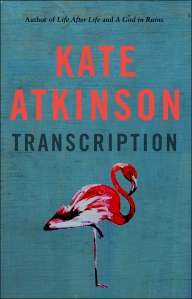 ’Transcription’ is the latest stand-alone novel by Kate Atkinson in which eighteen-year-old Juliet Armstrong is recruited straight out of school by MI5 in 1940 not long after her mother has died. Initially given secretarial tasks as well as the roles usually left to women such as making the tea, she soon begins transcription work monitoring the conversations held in a flat in Pimlico between Fascist sympathisers and an undercover British agent named Godfrey Toby who poses as a member of the Gestapo. A decade later, she is working as a radio producer of children’s programmes at the BBC believing that her wartime activities now lie in the past. However, a chance encounter with Godfrey (also known as John Hazeldine), some threatening notes and a sense that she is being followed remind her that the world of espionage is not one easily left behind and there are some who want Juliet to know that her actions have had far-reaching consequences.
’Transcription’ is the latest stand-alone novel by Kate Atkinson in which eighteen-year-old Juliet Armstrong is recruited straight out of school by MI5 in 1940 not long after her mother has died. Initially given secretarial tasks as well as the roles usually left to women such as making the tea, she soon begins transcription work monitoring the conversations held in a flat in Pimlico between Fascist sympathisers and an undercover British agent named Godfrey Toby who poses as a member of the Gestapo. A decade later, she is working as a radio producer of children’s programmes at the BBC believing that her wartime activities now lie in the past. However, a chance encounter with Godfrey (also known as John Hazeldine), some threatening notes and a sense that she is being followed remind her that the world of espionage is not one easily left behind and there are some who want Juliet to know that her actions have had far-reaching consequences.
Opening in 1981 when Juliet is hit by a car in London, the story hops back and forth between 1940 and 1950. Historical fiction is a genre which can become bogged down in detail but Atkinson’s prose is nimble in its quirkiness and she doesn’t waste time dwelling on the wider context of the war and neither do her characters. At first, the transcription work Juliet becomes involved in is mostly routine and mundane as she attempts to decipher lots of inaudible mumbling, before progressing to more dangerous operations in order to infiltrate networks more directly. Although Juliet comes across as a rather naive character at times, she also turns out to be a wry observer of the world which makes it hard to pin down exactly how much she really knows, to the point where she becomes almost as enigmatic as her handlers.
‘Transcription’ is a novel stuffed with many of Atkinson’s trademark strengths – a non-chronological structure, dry humour and a lightly drawn but no less compelling mid-20th century setting. Her perceptive take on family dynamics done so well in Behind the Scenes at the Museum and A God in Ruins in particular is much less prominent in ‘Transcription’, but the careful plotting and numerous red herrings which lead up to the twist at the end indicates that her unique style of detective fiction (for which she is best known as the author of the Jackson Brodie novels) is also well suited to the betrayals and multiple identities associated with wartime espionage where appearances are never quite what they seem.





I very much enjoyed this novel, but felt that it got caught between the style of the Brodie novels and that of works like Life After Life and A God in Ruins. I’m looking forward to this summer’s new Brodie novel.
LikeLike
Yes, I prefer the family dynamics of her “literary” novels overall. I read Case Histories a few years ago and plan to reread it along with the other Jackson Brodie novels at some point.
LikeLike
I loved this book, but to be fair, I think I’d read her shopping list and give it all the stars. I know what you mean, about it feeling caught between the Brodie novels and her more literary work but I think that’s why I liked it…
LikeLiked by 1 person
Great review! I didn’t love Case Histories, but I’d be up for trying another book by Atkinson and I’ve heard good things about this one.
LikeLiked by 1 person
Pingback: Reading between the lines? – Annabookbel